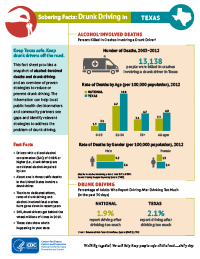What Works: Strategies to Reduce or Prevent Drunk Driving
The strategies in this section are effective for reducing or preventing drunk driving. They are recommended by The Guide to Community Preventive Services and/or have been demonstrated to be effective in reviews by the National Highway Traffic Safety Administration.* Different strategies may require different resources for implementation or have different levels of impact. Find strategies that are right for your state.
Drunk driving laws
Drunk driving laws make it illegal nationwide to drive with a BAC at or above 0.08%. For people under 21, “zero tolerance” laws make it illegal to drive with any measurable amount of alcohol in their system. These laws, along with laws that maintain the minimum legal drinking age at 21, are in place in all 50 states and the District of Columbia, and have had a clear effect on highway safety, saving tens of thousands of lives since their implementation.
Sobriety checkpoints
Sobriety checkpoints allow police to briefly stop vehicles at specific, highly visible locations to see if the driver is impaired. Police may stop all or a certain portion of drivers. Breath tests may be given if police have a reason to suspect the driver is intoxicated.
Ignition interlocks
Ignition interlocks installed in cars measure alcohol on the driver’s breath. Interlocks keep the car from starting if the driver has a BAC above a certain level, usually 0.02%. They’re used for people convicted of drunk driving and are highly effective at preventing repeat offenses while installed. Mandating interlocks for all offenders, including first-time offenders, will have the greatest impact.
Multi-component interventions
Multi-component interventions combine several programs or policies to prevent drunk driving. The key to these comprehensive efforts is community mobilization by involving coalitions or task forces in design and implementation.
Mass media campaigns
Mass media campaigns spread messages about the physical dangers and legal consequences of drunk driving. They persuade people not to drink and drive and encourage them to keep other drivers from doing so. Campaigns are most effective when supporting other impaired driving prevention strategies.
Administrative license revocation or suspension laws
Administrative license revocation or suspension laws allow police to take away the license of a driver who tests at or above the legal BAC limit or who refuses testing. States decide how long to suspend the license; a minimum of 90 days is effective.
Alcohol screening and brief interventions
Alcohol screening and brief interventions take advantage of “teachable moments” to identify people at risk for alcohol problems and get them treatment as needed. This combined strategy, which can be delivered in health care, university, and other settings, helps change behavior and reduces alcohol-impaired crashes and injuries.
School-based instructional programs
School-based instructional programs are effective at teaching teens not to ride with drunk drivers. More evidence is needed to see if these programs can also reduce drunk driving and related crashes.
*Sources
- The Guide to Community Preventive Services (The Community Guide), Motor Vehicle-Related Injury Prevention
- National Highway Traffic Safety Administration. (2015). Countermeasures That Work: A Highway Safety Countermeasures Guide for State Highway Safety Offices, 8th edition.
State Fact Sheets and Data
 Working together, we can help keep people safe on the road – every day. Keep drunk drivers off the road.
Working together, we can help keep people safe on the road – every day. Keep drunk drivers off the road.
Fact sheets are available for each state and the District of Columbia and include national and state data on drunk driving and alcohol-involved crash deaths, as well as an overview of proven strategies for reducing and preventing drunk driving.
Need data for your state? View and download seat belt datasets from our State Data web page.
Related Pages
- Sobering Facts: Drunk Driving State Fact Sheets
- Drunk Driving State Data and Maps
- Impaired Driving: Get the Facts
- Drunk Driving US Map
- Drunk Driving Death Rates US Map
- Effects of Blood Alcohol Concentration (BAC)
- State-Based Motor Vehicle Data & Information
-
data.cdc.gov
View and download dozens of motor vehicle datasets and visualizations, including charts and maps, on data.cdc.gov.
-
Motor Vehicle Prioritizing Interventions and Cost Calculator for States (MV PICCS)
CDC offers a new interactive calculator to help state decision makers prioritize and select from a suite of 14 effective motor vehicle injury prevention interventions. MV PICCS is designed to calculate the expected number of injuries prevented and lives saved at the state level and the costs of implementation, while taking into account available resources.
-
CDC's Safe Driving Board on Pinterest
Help spread the word about the dangers of drunk driving. Visit the CDC Safe Driving Pinterest board for ready-to-share graphics and social media content.
- Page last reviewed: March 22, 2016
- Page last updated: March 22, 2016
- Content source:
- Centers for Disease Control and Prevention,
- National Center for Injury Prevention and Control,
- Division of Unintentional Injury Prevention


 ShareCompartir
ShareCompartir
